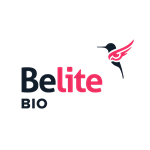Belite Bio, Inc. (NASDAQ: BLTE) (“Belite Bio” or the “Company”) today announced additional findings from the 24-month Phase 2 study of Tinlarebant in adolescent Stargardt disease (STGD1) at the Association for Research in Vision and Ophthalmology (ARVO) Annual Meeting.
- Additional analysis of visual acuity loss, genotypic profiles, and retinal imaging data from a 24-month Phase 2 trial of Tinlarebant in adolescent Stargardt disease patients provides further support for the potential of Tinlarebant to slow and potentially halt lesion growth
- In 5 of 12 subjects (42%) with known pathogenic ABCA4 mutations, no incident atrophic (DDAF) lesions were formed during the 24-month treatment period and no change in QDAF was observed
- A novel lesion size quantification method that can better detect atrophic lesions revealed 8 of 12 subjects with atrophic lesion involvement within the macula at baseline; growth of these lesions into the macula was halted during the second year
- In 6 subjects with prior bilateral BCVA loss (mean ~10 letters/year), mean BCVA loss over 24 months was 1.9 letters/year
- Sibling subjects with identical ABCA4 mutations showed different rates of QDAF/DDAF lesion growth and BCVA loss
- Tinlarebant is currently being evaluated in adolescent Stargardt disease in a Phase 3 DRAGON study, with interim data expected in 4Q 2024, and a combination Phase 1b and Phase 2/3 DRAGON II trial, and in Geographic Atrophy in a Phase 3 PHOENIX study
SAN DIEGO, May 06, 2024 (GLOBE NEWSWIRE) -- Belite Bio, Inc. (NASDAQ: BLTE) (“Belite Bio” or the “Company”), a clinical-stage biopharmaceutical drug development company focused on advancing novel therapeutics targeting degenerative retinal diseases that have significant unmet medical needs, today announced additional findings from the 24-month Phase 2 study of Tinlarebant in adolescent Stargardt disease (STGD1) at the Association for Research in Vision and Ophthalmology (ARVO) Annual Meeting. Tinlarebant is Belite Bio’s orally administered tablet intended to slow disease progression in patients affected with STGD1 and Geographic Atrophy (GA) in advanced Dry Age-related Macular Degeneration (Dry AMD).
Genetic profiling was performed on the 13 adolescent STGD1 patients enrolled in a Phase 2 study of Tinlarebant. Eleven of these subjects (85%) harbored severe pathogenic/likely pathogenic ABCA4 variants. Despite these severe variants, 42% of Tinlarebant-treated subjects (5 out of 12) did not develop incident atrophic (definitely decreased autofluorescence, DDAF) retinal lesions and no change in questionably decreased autofluorescence (QDAF) was observed during the 24-month treatment period. Incident atrophic lesions appeared in seven subjects at different timepoints over 24 months; four of these subjects developed DDAF lesions after month 12. The mean DDAF lesion growth at month 24 was 0.51 mm2 with a range of variation of 0.4 mm2, a growth rate that is significantly lower than what has been observed in natural history studies. Importantly, six STGD1 patients who had a mean bilateral best corrected visual acuity (BCVA) loss of 10 letters per year prior to enrollment in the Phase 2 study showed a mean BCVA loss equivalent to 1.9 letters per year during the 24-month treatment period. Analysis of genotype-phenotype relationships revealed that sibling subjects with identical ABCA4 mutations had different rates of lesion growth and BCVA loss indicating that identical genotypes do not necessarily predict an identical course of disease.
Notably, retinal imaging data from the Phase 2 study was reanalyzed using a novel lesion size quantification method that utilizes a mathematical classification of lesions to reduce subjective reader bias and provide enhanced accuracy and superior precision compared to the traditional method of DDAF lesion quantification. This analysis revealed DDAF lesions within the macula in 12 eyes of eight subjects at baseline. Analysis of change in atrophic lesion area within the macula of these eyes over 24 months showed a halt in lesion growth into the macula after 16 months. This finding is consistent with the observed stabilization of visual acuity.
“Data from the genotype and lesion growth analyses from our completed Phase 2 trial continues to demonstrate the efficacy of Tinlarebant,” said Dr. Nathan Mata, CSO of Belite Bio. “The stabilization of visual acuity, particularly in patients with significant visual acuity loss prior to study enrollment, as well as the observation that 42% of the Tinlarebant-treated subjects did not develop atrophic retinal lesions during the course of treatment despite the presence of severe pathogenic ABCA4 variants, suggests that Tinlarebant holds great promise toward slowing or even preventing the development of atrophic lesions to alter the course of disease and provide a meaningful benefit for patients.”
“Traditional measurement of DDAF relies heavily on subjective assessment of the grader without a specific focus on key regions, potentially leading to less precise measurements,” added Professor John Grigg, Principal Investigator, Head Specialty of Ophthalmology at the University of Sydney and Consultant Ophthalmologist at the Sydney Children’s Hospitals Network at Westmead and Sydney Eye Hospital who presented the data. “The recent analysis of retinal images using a novel lesion size quantification method that focuses solely on the macular region or even smaller areas with greater precision and accuracy, revealed that 8 subjects did have atrophic lesions within the macula at the time of enrollment. Moreover, analysis of change in atrophic lesion area within the macula in these subjects over 24 months reveals that the lesion growth has stopped after month 16. These findings suggest that the baseline character of the subjects in the Phase 2 trial is similar to the those in the ongoing Phase 3 trial and similar outcome may be expected in the ongoing Phase 3 trials, and Tinlarebant may not only prevent healthy retinal cells from A2E damage, but also potentially even halt disease progression.”
These new findings continue to support Tinlarebant as a promising oral treatment for STGD1 patients. The presentation is now available in the “Presentations & Events” section of Belite Bio’s website: https://investors.belitebio.com/presentations-events/events.
About Tinlarebant (a/k/a LBS-008re)
Tinlarebant is a novel oral therapy that is intended to reduce the accumulation of vitamin A-based toxins (known as bisretinoids) that cause retinal disease in STGD1 and also contribute to disease progression in GA, or advanced Dry AMD. Bisretinoids are by-products of the visual cycle, which is dependent on the supply of vitamin A (retinol) to the eye. Tinlarebant works by reducing and maintaining levels of serum retinol binding protein 4 (RBP4), the sole carrier protein for retinol transport from the liver to the eye. By modulating the amount of retinol entering the eye, Tinlarebant reduces the formation of bisretinoids. Tinlarebant has been granted Fast Track Designation and Rare Pediatric Disease designation in the U.S., and Orphan Drug Designation in the U.S. Europe, and Japan for the treatment of STGD1.
Stargardt Disease (STGD1)
STGD1 is the most common inherited retinal dystrophy (causing blurring or loss of central vision) in both adults and children. The disease is caused by mutations in a retina-specific gene (ABCA4), which results in progressive accumulation of bisretinoids leading to retinal cell death and progressive loss of central vision. The fluorescent properties of bisretinoids and the development of retinal imaging systems have helped ophthalmologists identify and monitor disease progression. Currently, there are no FDA approved treatments for STGD1.
Importantly, STGD1 and GA, or advanced Dry AMD, share a similar pathophysiology, which is characterized by the excessive accumulation of bisretinoids, retinal cell death, and progressive loss of vision. Vision loss occurs slowly, despite peripheral expansion of “dead retina,” until the disease reaches the center of the eye (the macula). Therefore, Belite Bio is evaluating safety and efficacy of Tinlarebant in GA patients in a 2-year Phase 3 study (PHOENIX).
About Belite Bio
Belite Bio is a clinical-stage biopharmaceutical drug development company focused on advancing novel therapeutics targeting retinal degenerative eye diseases which have significant unmet medical needs such as (i) atrophic age-related macular degeneration (AMD), commonly known as Geographic Atrophy (GA) in advanced dry AMD, and (ii) autosomal recessive Stargardt disease type 1, or STGD1, in addition to specific metabolic diseases. For more information, follow us on Twitter, Instagram, LinkedIn, Facebook or visit us at www.belitebio.com.
Important Cautions Regarding Forward Looking Statements
This press release contains forward-looking statements about future expectations and plans, as well as other statements regarding matters that are not historical facts. These statements include but are not limited to statements regarding the potential implications of clinical data for patients, and Belite Bio’s advancement of, and anticipated preclinical activities, clinical development, regulatory milestones, and commercialization of its product candidates, and any other statements containing the words “expect”, “hope” and similar expressions. Actual results may differ materially from those indicated in the forward-looking statements as a result of various important factors, including but not limited to Belite Bio’s ability to demonstrate the safety and efficacy of its drug candidates; the clinical results for its drug candidates, which may not support further development or regulatory approval; the timing to complete relevant clinical trials and/or to receive the interim/final data of such clinical trials; the content and timing of decisions made by the relevant regulatory authorities regarding regulatory approval of Belite Bio’s drug candidates; the potential efficacy of Tinlarebant, as well as those risks more fully discussed in the “Risk Factors” section in Belite Bio’s filings with the U.S. Securities and Exchange Commission. All forward-looking statements are based on information currently available to Belite Bio, and Belite Bio undertakes no obligation to publicly update or revise any forward-looking statements, whether as a result of new information, future events or otherwise, except as may be required by law.
Media and Investor Relations Contact:
Jennifer Wu /ir@belitebio.com
Julie Fallon /belite@argotpartners.com






